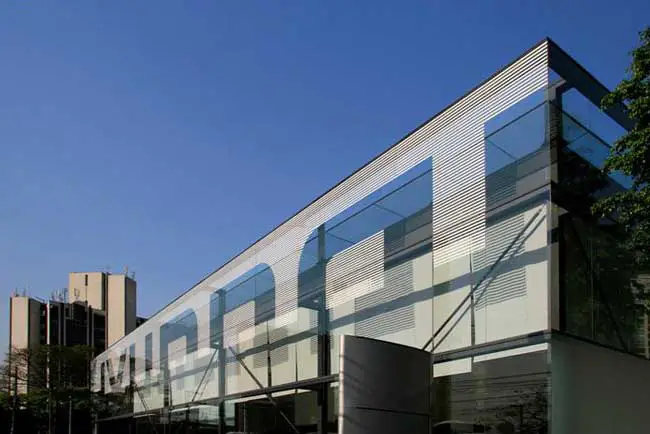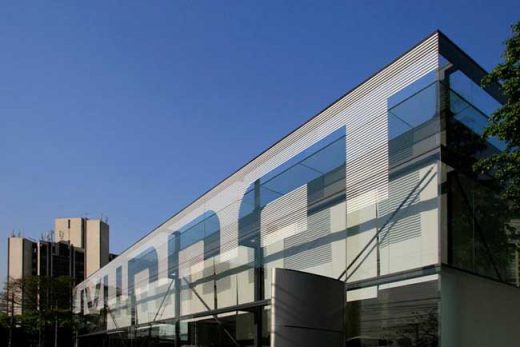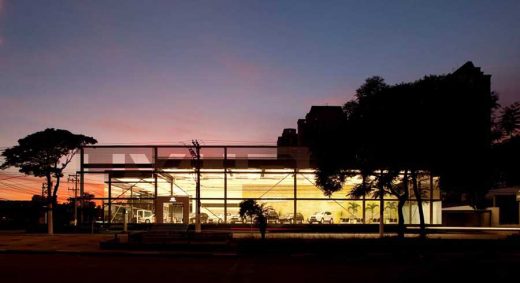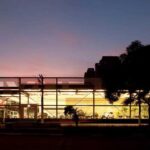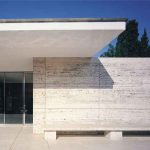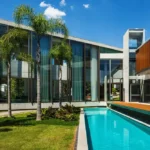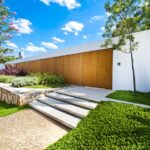Hyundai Pavilion São Paulo Design Photos, South America Building Architect
Hyundai Pavilion São Paulo : Brasil Architecture
Contemporary Brazilian building design by Spadoni & associados architects
post updated 6 September 2024
Location: São Paulo, SP, Brazil, South America
Date built: 2010
Photos by Leonardo Finotti
30 Jan 2010
Hyundai Pavilion
Category: Display
Location: São Paulo, Brazil
Architect: Spadoni & Associados Arquitetura, São Paulo, Brazil
WAF Entry: 2010
Award: World Architecture Festival 2010 – Shortlisted
Photographs: Leonardo Finotti, São Paulo, Brasil, 2010
Hyundai Pavilion
The Hyundai Pavilion, located in a symbolical corner of the city of São Paulo, can be described from two elements: a glass wall to the front of the main avenue, detached from the building’s main structure, which receives the brand’s logo and two central blocks which contain the programme. Wall and main structure sometimes split in two elements; sometimes join themselves as a solid.
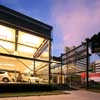
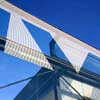
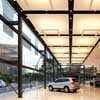
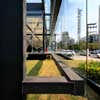
photographs : Leonardo Finotti
The project was developed to be executed in three months. Therefore, Spadoni & associados had to structure it under rational constructive bases and favor the expression of the used materials.
STRUCTURE The pavilion was inserted in a L shape, which two legs have approximate dimensions of 45m length x 12,5m width x 8m height, and is supported in the façades by profiles of HP 250 x 92 rolled steel columns, with the spacing between the axis varying between 8,75m and 10m.
Between these columns, rectangular tubular steel beam are responsible for the main support of the roofing near by the façades. With the height of 550mm, the beams are made with two U-type profiles, rigidified in the dimensions of 550mm x 123mm x 35mm x 6,3mm.
Reaching beyond the 12,5m width of the pavilion, W 360 x 44 laminated beams create the necessary support to the light sandwich type metallic tile of the roofing. With the spaces between the axis varying between 3,75m and 5m, the beams are sustained in the tubular beams of the façades and in the walls from the back of the pavilion.
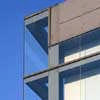
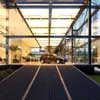
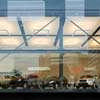
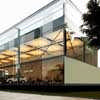
photographs : Leonardo Finotti
These walls have a mixed structure, formed by pillars and beams in reinforced concrete and masonry reinforced in concrete blocks and are responsible for the stability of the structure in this section. As for the façades, the responsible elements for the stability of the metallic structure are the diagonals in tubular steel profiles with the diameter of 76mm and thickness of 4,25mm.
Internally, the great structural element is the mezzanine. With a rectangular shape, sized 16,5m length and 6,45m width, this mezzanine has two of its sides free from supporting spots in the floor of the showroom. The free sides of the mezzanine’s floor are formed by W 610 x 125 rolled steel beams.
These beams are, in one of the sides, supported in the reinforced concrete structure of the back walls. The free vertex of the mezzanine is formed by a W 310 x 38,7 rolled steel profile architrave, anchored through metallic inserts in the concrete structure of the back. For the support of this mezzanine’s slab, W310 x 38,7 profiles overcome the 6,45m void.
The laminated profiles are made of ASTM A-572 steel. As for the profiles in folded plates and connection plates was used the ASTM A-36 steel. All the connections between the profiles are of the soldered type, with the solder made in loco.
CLOSURE The closure envelope of the pavilion is formed by big wall surfaces. The surface facing the Morumbi Avenue is sized 30m length x 8m height. As for the one facing the Chucri Zaidan Avenue, the dimensions are 45m length x 9,6m height, overcoming the 7m height of the showrom.
These wall surfaces are formed by 12mm thick laminated glass panels, with horizontal modulation of 1,25m and vertical of 3,2m. Positioned in front of the metallic structure, these panels are fixed only in the horizontal structures of the pavilion – the horizontal pillars have been suppressed – and happen in two distinct ways.
In the intermediate levels, horizontal metal bars that run from end to end supported on the columns of the superstructure of the pavilion were created. Formed by the union of two profiles of W 250 X 25,3 rolled steel, the bars are split from the other columns in 70cm with steel spacers of the same gauge of the bars. The connections between columns, spaces and bars have been made with a soldering process.
Profiles of folded plates of stainless steel, soldered in all the extension of the bars, create the supporting spots which are necessary for the wall plates from the upper modules.
Hyundai Pavilion São Paulo images / information from Spadoni & associados
Location: Sao Paolo, SP, Brazil, South America
Architecture in São Paulo
Contemporary Architecture in São Paulo
São Paulo Architecture Designs – chronological list
Edificio POD, Rebouças, district of Pinheiros, SP
Design: FGMF Arquitetos
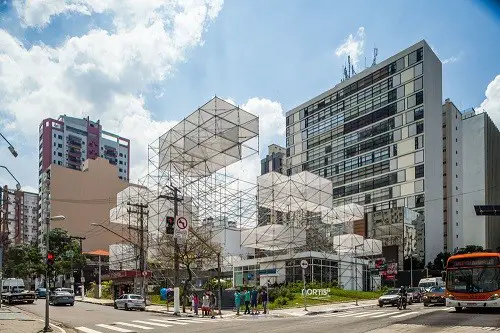
photography : Rafaela Netto
Edificio POD
Design: Königsberger Vannucchi Architects
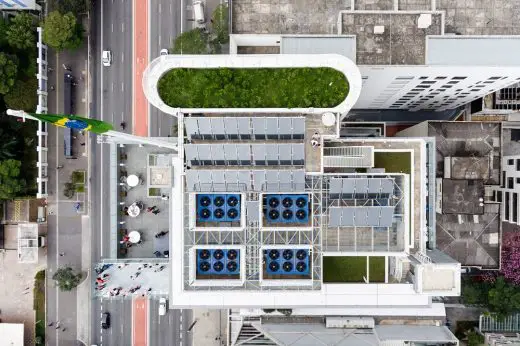
photography : Pedro Vannucchi
SESC Avenida Paulista Building
Youturn Pavilion São Paulo, Brazil
Youturn Pavilion São Paulo
HyunDai Pavilion Yeosu Expo, South Korea
Design: UnSangDong Architects
Architectural Designs
Contemporary Building Designs – recent architectural selection from e-architect below:
Comments / photos for the Hyundai Pavilion São Paulo Brazil page welcome
Website: Visit São Paulo

